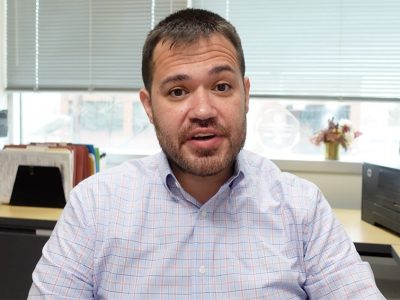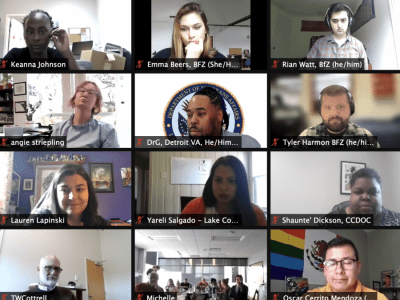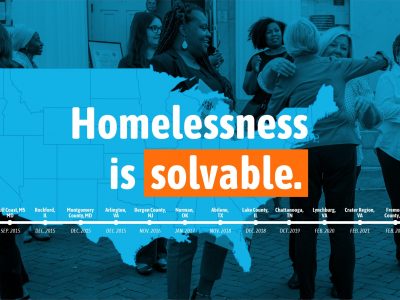In late May, Built for Zero leaders and staff hosted a webinar called Successful Public Health & Homelessness System Collaboration: Community Examples from the Frontlines. This call, moderated by Dawn Gilman of the Jacksonville Built for Zero team, featured panelists from communities that have partnered successfully with public health and health care delivery systems to implement solutions that move forward the work of ending homelessness as part of the public health response to COVID-19.
Panelists discussed how they have created or deepened these partnerships to develop a response that builds community capacity to end homelessness. They also explored specific solutions and innovations their communities have developed to respond to the pandemic, as well as the dynamics of how the partnerships were built and how their ways of working changed as a result of collaboration on COVID-19 response.
Below are the questions discussed by the panel of community members.
What’s something that you are most proud of, that your community has done thus far?
Mary Simons
Executive Director, Open Doors Homeless Coalition — Gulf Coast, MS
- “Our community has built on existing partnerships. As we tackle this crisis in front of us, we have strengthened those partnerships and use those partnerships to move into new partnerships with the department of health, with emergency management, with other people.”
- The team intends to maintain those partnerships no matter how long the pandemic lasts, and they don’t want to lose sight of the end goal: ending homelessness.

“We need this in the realm of ending homelessness: keeping everyone safe, keeping everyone healthy.”
– Mary Simons
Julia Orlando
Director, Bergen County Housing, Health & Human Services Center — Bergen County, NJ
- Bergen County is in the epicenter of the pandemic, right outside of New York City, which has had a significant impact on their community
- They have had to close their flagship 27,000 square-foot facility that serves as a “one-stop” facility, enabling individuals to access shelter, food, medical evaluations and linkages to housing support.
- However, none of the people in their care got sick, and the 90 people they normally have under their care were diverted to family or friends’ places, motels, or permanent housing.
- Since the pandemic started, they have housed 27 people, and they are currently in the housing search for dozens more clients.
- “Once those collaborations and those partnerships are strong, they can translate, they can be flexible, and they can work differently in a changing environment.”
- One of Julia’s concerns is that more people will become homeless in her community once eviction moratoriums end in the fall, alongside the threat of the flu and a possible resurgence of COVID-19.
Andrea Kurtz
Senior Director, Housing Services, United Way of Forsyth County — Winston-Salem, NC
- Their community has also built on and deepened existing partnerships in a way that has allowed them to respond to the crisis.
- Their approach focuses on not only those people who may already be sick, but also on prevention of others getting sick.
- Their team first identified how their shelters could continue to operate in a healthy way as an immediate response, after which they looked at their short-, medium-, and long-term responses.
- “All of the new partners who have come to the table are sticking in with us in that longer-term vision, which to me is a great sign that we’ve built lasting partnerships that will help us respond not only to this pandemic but [also to any others that may come.]”
- Other systems are now able to see the health challenges that people they serve often face, in order to look at how future responses could be improved.
Dawn Gilman
Chief Executive Officer, Changing Homelessness — Jacksonville, FL
- “What I am most proud of is that we, as a community, have kept asking ‘what next?’ and how [we can] do it better.”
- Through national and health care partnerships, almost 700 people experiencing homelessness have been tested for COVID-19 — and no one had tested positive, even after running the tests twice.
- Anyone who came into the shelter or drop-in center was offered a test.
Allison Martin
Director, Case Management, University of Florida Health, Jacksonville — Jacksonville, FL
- While they have had close relationships with homeless shelters and the resources supporting the homeless population, it has historically consisted of a handoff.
- The hospital has contractual relationships with some of the shelters to ensure patients have access to shelters.
- In light of the COVID-19 epidemic, the partnership has now functioned more in real-time, allowing for an understanding of each organizations’ processes, needs, strengths, and weaknesses
- The team also took the opportunity to figure out how to more appropriately help patients who come through the emergency room system to make sure they receive the support they need without necessarily admitting them into hospital space already limited due to the pandemic.
- Some of the smaller takeaways and recent “aha” moments from this partnership: discovering who to contact to escalate a matter or what a provider’s preferred method of communication may be.
Denise Price
Assistant Public Health Director, Forsyth County Dept. of Public Health — Winston-Salem, NC
- The team has accomplished a lot in a short period of time.
- Prior to the COVID-19 pandemic, Denise and Andrea in Winston-Salem may have known each others’ names, but had never really sat down and had a conversation.
- “In the short period of time, really what I think gelled us the quickest was having a common mission, and that was to address the immediate need around the COVID crisis.”
- Staying in the confines of their shared goals and mission allowed the systems and processes and to build those out within the partnership.
- Once they had a model to address the immediate need, the team transitioned to planning for longer-term needs by creating a more sustainable model, making sure to have the same people at the table providing input.
What kinds of conversations have you had to have as you deal with this type of crisis?
Julia Orlando
Director, Bergen County Housing, Health & Human Services Center — Bergen County, NJ
- One of the most notable experiences at the beginning of the crisis was the chaos of it, especially because their community was near the epicenter of New York City
- With their shelter closed, they would often struggle to figure out “who’s it?” and to support clients who were often not in the system. Even in her own role as director, case management became Julia’s primary role.
- As a remedy, Julia began adding each person she talked to as a new contact in her phone, which led to impromptu conference calls and troubleshooting conversations, where everyone would solve problems like finding transportation to and from hospitals, food sources, motel options, and more.
- “We started to put together in real-time, very basic solutions.”
- The team at Bergen County began to focus on how they could make it easier for the hospitals, because they knew that it would be their clients who may end up there in critical care.
- “My whole argument is [that] if I’m going to keep them out of the hospital, we need to keep them safe in the community, so how do we do that together? And everybody was on board with that.”
- The relationship between the homeless response system and healthcare strengthened because at that moment, the hospital needed the help, but in three months, the homeless response system will be the ones needing assistance and support.

“We’re all moving in the same direction. Each of our communities is completely the same and absolutely different.”
– Dawn Gilman
Dawn Gilman
Chief Executive Officer, Changing Homelessness — Jacksonville, FL
- The COVID-19 crisis allowed their team to be more anticipatory and vocal about next steps, while also problem-solving on the fly to address the clients’ immediate needs, whether it be testing, transportation, telehealth, or something else.
- The team was able to stand up a basic protocol in 45 days, through twice-weekly meetings and consistent collaboration — a process that would normally take a year or two to do.
- Since hospitals operate 24/7/365 and can discharge people at irregular hours, communication, organization, and commitment have been key factors in making their partnership a successful one.
Andrea Kurtz
Senior Director, Housing Services, United Way of Forsyth County — Winston-Salem, NC
- In the past, hospitals would often discharge patients from the ER to a shelter in the middle of the night, when providers were often not prepared to bring in new clients.
- Once the hospital and shelters were able to identify this misalignment, hospitals began discharging patients during the daytime hours, which allowed providers to welcome them in a more client-centered way.
- As a result of the pandemic, the community’s CRRC Board has had a greater variety of representatives from each system at the table, each bringing their own multidisciplinary perspectives and approach to problem-solving.
- This shift “…has really helped change how we’re able to interact with each other and create solutions that are working for everybody better than they were before.”
Will organizations be able to use this experience to streamline policies, procedures, and decisions?
Dawn Gilman
Chief Executive Officer, Changing Homelessness — Jacksonville, FL
- Yes, but more importantly, it’s connecting different policies to different systems.
- With people being more available to reach in a pandemic, you can get the right people at the table to have these conversations and move these policies through.
- For example, after sheltering people in hotels, the next step will be how to accelerate strategies for moving those same clients into housing.
Mary simons
“We’ve been able to broaden out those solutions to say, ‘Wait a minute, this is bigger than what homeless services can do.’”
Mary Simons
Executive Director, Open Doors Homeless Coalition — Gulf Coast, MS
- Conversations are now centered around how each part of different systems can work together. Homeless service providers may not be able to accomplish certain things on their own, but they are thrilled to be a partner to help another entity.
- “We’re almost used to being the last resort and having to come up with all the solutions. Now is an opportunity to do our part, but actually have the people who are in the decision-making roles in the different organizations to also do their part, so that we can as a community deliver the best service for people in need.”
How do you think your community has balanced addressing the immediate health needs of medically vulnerable or older adults, and with other people experiencing homelessness?
Denise Price
Assistant Public Health Director, Forsyth County Dept. of Public Health — Winston-Salem, NC
- In Forsyth County, they have addressed these priority areas as two different groups.
- For individuals experiencing homelessness who are either coded positive, pending test results, or known contact, the team identified and staffed a facility with three separate areas.
- However, utilization of this facility has been low, due to excellent work of the shelters and early proactive measures taken there, including social distancing and infection prevention efforts.
- The second priority group is managed by the city, which provides housing in hotels/motels for individuals who are medically fragile.
Denise Price
“What is our goal? What is our mission? Let’s focus on today and what we need to do to keep people safe and healthy.”
Andrea Kurtz
Senior Director, Housing Services, United Way of Forsyth County — Winston-Salem, NC
- The shelters for the medically fragile have only been accepting people who couldn’t be safe sheltering where they were 24/7.
- The team worked closely with the health department to ensure that shelters could still operate during the pandemic and continue their normal operations in the safest manner possible.
- Now that North Carolina is seeing a surge of coronavirus cases, many shelter operators have grown very nervous, but public health partners have been there to provide reassurance and guidance as to how they can continue to operate safely.
Allison Martin
Director, Case Management, University of Florida Health, Jacksonville — Jacksonville, FL
- A beneficial decision in in-patient settings has been to assign a designated COVID case manager to COVID cases, which allowed them to have a specialist in the hospital who could keep up with COVID-related resources.
- In regards to their senior population, the healthcare providers have kept close contact with their post-acute facilities, assisted living, and nursing facilities so they knew how they were doing and what their admission process was looking like.
- Outreach to these facilities was conducted in the first couple of weeks of the pandemic because the team recognized this relationship would be good to have.
- For their homeless population, it was important for the healthcare providers to keep their finger on the pulse of what was going on, who is accepting clients at what time of the day, what limitations are in place, and how to make more successful transitions.
- The shared goal is to move someone from the hospital to an appropriate, alternative, and safe setting.
- “These are shared patients. A patient who is in a homeless shelter is not just a homeless community member. They are also eventually my hospital patient. And when they’re my hospital patient, they’re not just my hospital patients. They’re also a member of your vulnerable homeless community.”
- Their shelter task force was able to come up with a solution that was perfect for their specific community, because all of the stakeholders were at the table.
- Because they are an academic hospital, University of Florida Health partnered with Quest Diagnostics to complete 332 COVID-19 tests in the homeless community and among vulnerable individuals who may not have otherwise had access to that testing.
Dawn Gilman
Chief Executive Officer, Changing Homelessness — Jacksonville, FL
- The homeless service providers in Jacksonville pushed to have COVID testing done as quickly as possible.
- If someone tested positive in a shelter, the shelter would be treated the same as a nursing home and be placed on lockdown for 14 days, unable to admit clients.
- Similar to other communities, they have one shelter for people who have tested positive for COVID-19 or those suspected of having COVID-19, and a second shelter for the medically vulnerable homeless.
- The second shelter is reserved for individuals moving off of the street, and the community’s permanent supportive housing by-name list has the most medical information, allowing them to prioritize the people they know based on that list.
- They are also anticipating overflow in their domestic violence shelters, so once ESG funding is released, they plan to set up a third hotel for individuals and families fleeing domestic violence, or people over the age of 18 who have been trafficked.
Are landlords in Bergen County showing apartments during the shutdown, or how was that working?
Julia Orlando
Director, Bergen County Housing, Health & Human Services Center — Bergen County, NJ
- There was a lot of anxiety initially, and boarding homes in the county stopped taking applications.
- Now, due to concerns that people may not be able to pay their rent in the near future, there’s an incredible interest in subsidy, especially from landlords.
- “I’ve had landlords actually reaching out to us to find out if we have availability.”
- The Bergen team has been conducting virtual tours with photos and videos, while using counseling and conversation to expedite the housing process and move people from motels.
- Some housing inspections have also been outsourced.
- “There [is] a little bit of silver lining here… this right now for us is an opportunity for landlords to start taking some of our clients that normally wouldn’t be as interested in because they want that guaranteed payment.”






